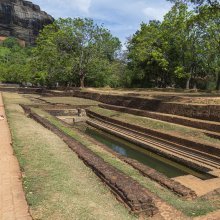Summer: 3 definitions
Introduction:
Summer means something in Hinduism, Sanskrit, the history of ancient India. If you want to know the exact meaning, history, etymology or English translation of this term then check out the descriptions on this page. Add your comment or reference to a book if you want to contribute to this summary article.
Images (photo gallery)
In Hinduism
Shilpashastra (iconography)
Source: Shodhganga: Elements of Art and Architecture in the Trtiyakhanda of the Visnudharmottarapurana (shilpa)The Summer Season follows specific guidelines in the tradition of ancient Indian Painting (citra), according to the Viṣṇudharmottarapurāṇa, an ancient Sanskrit text which (being encyclopedic in nature) deals with a variety of cultural topics such as arts, architecture, music, grammar and astronomy.—Every season has its own peculiarities and charms. The seasons (e.g., Summer) always encourage the painters to grab different ideas from the nature. The Viṣṇudharmottarapurāṇa also gives some instructions to make the picture of every season beautiful and natural. The summer season (grīṣma) should be exhibited with the picture having tired men, deer-wandering for shade, buffaloes-hiding themselves in mud to get rid of heat and dried water sources like pools, lakes etc. projecting the season of drought.

Shilpashastra (शिल्पशास्त्र, śilpaśāstra) represents the ancient Indian science (shastra) of creative arts (shilpa) such as sculpture, iconography and painting. Closely related to Vastushastra (architecture), they often share the same literature.
Kavyashastra (science of poetry)
Source: Shodhganga: Elements of Art and Architecture in the Trtiyakhanda of the Visnudharmottarapurana (kavya)The Summer Season is beautifully portrayed in the Ṛtusaṃhāra of Kālidāsa.—In the Ṛtusaṃhāra, giving the description of the summer season, Kālidāsa says that the summer season is the hot season when the sun becomes fierce and the moon becomes peaceful. Due to the hot weather, the animal of the forest become exhausted and that is why even the peacocks do not kill the serpents. The wild pigs hide themselves in ponds wherein the mud dries up.

Kavyashastra (काव्यशास्त्र, kāvyaśāstra) refers to the ancient Indian tradition of poetry (kavya). Canonical literature (shastra) of the includes encyclopedic manuals dealing with prosody, rhetoric and various other guidelines serving to teach the poet how to compose literature.
India history and geography
Source: Singhi Jain Series: Ratnaprabha-suri’s Kuvalayamala-katha (history)Summer season was was vividly depicted in the Kathās (narrative poems) such as Uddyotanasūri in his 8th-century Kuvalayamālā (a Prakrit Campū, similar to Kāvya poetry).—Page 112.28-33, also 113.1-26: There is a description of the summer season which is extremely rare both in Sanskrit and Prakrit literature, the only other instance known to me is in the Harṣacarita of Bāṇa.

The history of India traces the identification of countries, villages, towns and other regions of India, as well as mythology, zoology, royal dynasties, rulers, tribes, local festivities and traditions and regional languages. Ancient India enjoyed religious freedom and encourages the path of Dharma, a concept common to Buddhism, Hinduism, and Jainism.
See also (Relevant definitions)
Starts with: Summer adonis, Summer blooming, Summer coralroot, Summer cypress, Summer damask rose, Summer fringe-rush, Summer grass, Summer lilac, Summer savory, Summer snowflake, Summerberry.
Full-text (+426): Grishma, Nidagha, Graishma, Naidagha, Uttarayana, Dakshinayana, Harmika, Graishmika, Graishmaka, Gimhika, Gimhana, Udagayana, Sugrishma, Bangala, Grishmakalina, Usma, Vasanta, Pausara, Pragriva, Vaishakha.
Relevant text
Search found 204 books and stories containing Summer; (plurals include: Summers). You can also click to the full overview containing English textual excerpts. Below are direct links for the most relevant articles:
Summers in the Kashmir Valley < [April – June, 2001]
To a Swallow < [July – September, 2008]
Question Across The Field < [December 1943]
Heimskringla (by Snorri Sturlson)
Chapter VII - Saga Of Olaf Haraldson
Part 67 - Account Of Their Reconciliation < [Chapter VII - Saga Of Olaf Haraldson]
Part 32 - Of King Adils' Marriage < [Chapter I - The Ynglinga Saga]
Blue Annals (deb-ther sngon-po) (by George N. Roerich)
Chapter 11 - Drigung Chojay lineage (viii): dbon sher 'byung < [Book 8 - The famous Dakpo Kagyü (traditions)]
Chapter 2b - Kyungpo Naljor disciples (iii): sangs rgyas gnyan ston choskyi shesrab < [Book 9 - Kodrakpa and Niguma]
Chapter 6 - First incarnation series (i): dus gsum mkhyen pa < [Book 8 - The famous Dakpo Kagyü (traditions)]
Sushruta Samhita, volume 4: Cikitsasthana (by Kaviraj Kunja Lal Bhishagratna)
Chapter XXVII - Elixirs (rasayana) for invulnerability to disease
Chapter X - The medical treatment of major cutaneous affections
Chapter XXVIII - Elixirs (rasayana) to improve memory and life span
Chapter XXV - The Religious Calendar
Chapter V - The Planets And Cosmology
The Garuda Purana (by Manmatha Nath Dutt)
Chapter CCXV - Various Recipes < [Dhanvantari Samhita]
Chapter CII - Duties of the order of forest dwelling hermits < [Agastya Samhita]
Chapter CXLVI - Description of the Nidanam of all the diseases < [Dhanvantari Samhita]
Related products
(+5 more products available)








